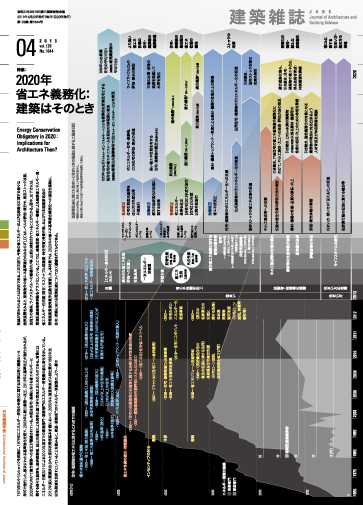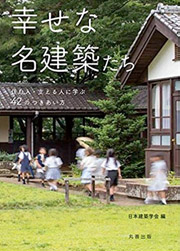本文PDFの閲覧につきましては、こちらでご確認ください。

2013-4月号 APRIL
特集= 2020年省エネ義務化
─建築はそのとき
Energy Conservation Obligatory in 2020: Implications for Architecture Then?
特集前言 「環境建築」からかっこが外れるとき
本誌では昨年6月号で特集「エネルギーホーリック建築」を組んだ。オイルショック以降、地球温暖化対策へと至る歴史過程を踏まえつつ、エネルギーと建築の関係に「3.11」がどのようなインパクトをもたらしたかを、エネルギーの供給側と、需要側(建築界)の両面に着目して記録する特集であった。
その後、国は省エネ・省CO2対策の今後の方向性について検討を進め、2012年7月に中間取りまとめを公表した。本特集では、この「2020年省エネ基準適合義務化」が、主として建築設計にとってどのような意味を持つのかを議論することとした。
「エネルギー使用の合理化に関する法律」(1979)に基づいて定められる省エネ基準は、何度かの改正を経て強化されてきたが、いまだ国際的には低い水準にとどまり、また、評価基準の複雑さなどに課題を残していた。今回、これが一次エネルギー消費量ベースで建物全体の省エネルギー性能を評価する基準へと改正される(2013年1月公布、建築物は2013年4月施行、住宅は2013年10月施行)。また、従来は一定規模以上の建築物についてその所有者に省エネ措置の努力義務を課すものだったが、今回政府が示したロードマップでは、2020年までにすべての新築建物について規模別の基準への適合を段階的に義務化する方針が示されている。その影響は住宅産業、メーカー、不動産業、そしてユーザー側の考え方やライフスタイルなど広範に及ぶだろうが、本特集では主に設計者にクローズアップすることとした。
第1部「環境建築─その闘いの記録」では、まず環境建築の日本における開拓者である岩村和夫・大野二郎・宿谷昌則・高間三郎・野沢正光の五氏にお集まりいただき、これまでの軌跡と現状の課題について議論いただいた。次に中村美和子氏に、環境に配慮した建築設計の日本における歴史的な歩みについて、1970年代から今日に至るまでを時期区分しつつ解説いただいた。
第2部では、「2020年省エネ基準適合義務化」の背景と内容を把握し、可能性と課題を展望する。まず、大島敦仁氏に今回改正された省エネ基準の趣旨と概要を解説いただいた。次に、省エネ基準をつくる立場にかかわってきた坂本雄三氏と、住宅の環境技術開発部門、ゼネコン設計部の環境・設備分野、建築家の立場からそれぞれ坂部芳平氏・高井啓明氏・中村勉氏をお招きし、座談会を行っている。
第3部「環境で勝つ─建築設計の新ステージ」では、環境を武器に建築のかたちを現実に変えつつある試みの胎動をとらえる。川島範久・川島宏起・田口知子・谷口景一朗・中川純・羽鳥達也の諸氏による座談会では、建築設計の今後の地平が広く展望されている。続けて、川島範久氏にはカリフォルニアにおけるサステイナブル・デザインの動向、山田浩幸氏には環境設計者の職能像、青木茂氏には環境性能に着目した既存建築改修の実験、山田貴宏氏には伝統的な素材・構法とパッシブ手法を通じた暮らしの総合的価値の創出について、それぞれ論じていただいた。さらに、森みわ氏にドイツの先進的状況、高偉俊氏と洪元和氏にそれぞれ中国と韓国の現状および対策について報告いただいている。
「義務化」は建築性能に求められる最低限のベースを担保しようとするものであり、その適用と評価、見直しのプロセス、それを適切に社会化するコミュニケーションや経済原理との積極的な調停が今後重要になる。また、このベースの上に、要素技術の加算を超えて豊かに構想されるべきトータルな建築デザインとこれに参画する職能、それを支える教育など、広範な視点が本特集を通じて提示されている。2020年あるいはその先の将来に向けて、建築と職能像はどのように変わっていくのか、また、それは長い歴史的パースペクティブのなかでどう位置付けられるものとなるだろうか。
*本特集の記事は2013年4月の新基準施行以前に執筆・作成されている。
会誌編集委員会
本号編集担当:前真之(東京大学)・渡邉浩文(東北工業大学)
[目次]
| 000 | 連載 再建への意志:図面のなかの都市復興 関東大震災復興期の共同建築/栢木まどか |
| 002 | 連載 東日本大震災|連続ルポ1|動き出す被災地 岩手県大槌町における災害公営住宅整備の進捗について─災害公営住宅の整備と管理をどうするか?/東研司 |
| 004 | 連載 東日本大震災|連続ルポ2|仮すまいの姿 応急仮設住宅居住者への支援活動─遠野まごころネットの取組み/柳澤亮 |
特集 2020年省エネ義務化:建築はそのとき
| 006 | 特集前言 「環境建築」から括弧が外れるとき |
第1部 環境建築─その闘いの記録
| 008 | 座談会 環境建築かく戦えり/岩村和夫 × 大野二郎 × 宿谷昌則 × 高間三郎 × 野沢正光 | |
| 014 | わが国における環境建築の潮流と課題̶今、新しい時代の潮流へ/中村美和子 |
第2部 2020 年省エネ基準適合義務化
| 018 | 改正省エネ基準の趣旨・概要/大島敦仁 |
| 022 | 座談会 なぜ省エネ義務化なのか/坂部芳平 × 坂本雄三 × 高井啓明 × 中村勉 |
第3部 環境で勝つ─建築設計の新ステージ
| 028 | 座談会 環境で勝つ─建築設計の新ステージ/川島範久 × 川島宏起 × 田口知子 × 谷口景一朗 × 中川純 × 羽鳥達也 |
| 034 | 建築とエネルギー─カリフォルニアにおけるサステイナブル・デザインの動向/川島範久 |
| 038 | 環境設計者という職能/山田浩幸 |
| 040 | リファイニング建築〈既存建築エコ改修〉/青木茂 |
| 042 | 総合価値としての住宅づくり─「里山長屋」の試み/山田貴宏 |
| 044 | ドイツの常識から学ぶ/森みわ |
| 045 | 中国の建築分野におけるエネルギー消費量の現状と省エネに向けた挑戦/高偉俊 |
| 046 | 韓国における建物分野の省エネルギー施策/洪元和 |
| 047 | 編集後記 前真之 + 渡邉浩文 |
| 047 | 次号予告 2013年5月号|特集:建築評価の現在形:脱中心化・断片化・ローコンテクスト化する言説環境とそのゆくえ |
| 048 | 特集を読んで 2013年2月号|特集:リスクコミュニケーション:3.11以後の変質と波及 東日本大震災後の変化と現状/片岡正和 地道にリスクコミュニケーション/梅本通孝 |
| 049 | 連載 建築の争点 「小規模校」か「統廃合」か─学校の規模/横山俊祐 |
| 050 | 連載 なぜ私は建築を選んだか 子どもの頃の一年間/藤森照信 |
| 051 | 連載 Architect Politician 青山剛室蘭市長/青山剛 |
| 052 | 連載 地域いろいろ・多様な日本 仏生山まちぐるみ旅館/岡昇平 |
Preface to the Special Issue: When the Quotation Marks Come Off "Environmental Architecture"
This journal featured "Energy-Holic Architecture" in its June 2012 issue. That feature, based on the historical process from the oil shock to provisions for global warming, and while aiming at both energy suppliers and markets (the world of architecture), recorded what impact 3.11 had on the relationship between energy and architecture.
Afterwards, the country advanced considerations of the future direction of countermeasures for saving energy and reducing CO2, and announced an interim plan in July 2012. In this feature, we decided to argue what this obligatory energy-conservation conformity standard 2020 means mainly for architectural design.
Although the energy-conservation standard based on the Act on the Rational Use of Energy (1978) has been strengthened through several revisions, it's still a low standard internationally, and there remain some issues such as the complexity of evaluation standards and so on. It will be revised into a standard evaluation for the energy-conservation performance of whole buildings on a primary-energy-consumption basis (the January 2013 proclamation, its April 2013 enforcement for buildings, and its October 2013 enforcement for houses). A duty for efforts at energy-conservation measures has been imposed on owners of buildings larger than a specific size, yet the government's current road map shows a principle by which all new buildings will be gradually obliged to conform to the standard for their classified size by 2020. And while the influence will be great throughout the housing industry, makers, real estate world, and user-side ways of thinking and lifestyles, this feature focuses mainly on architects.
In part 1, "Environmental Architecture -- Its Battle Record," first, Kazuo Iwamura, Jiro Ohno, Masanori Shukuya, Saburo Takama, and Masamitsu Nozawa together discuss the previous locus and issues of the status quo. And next, Miwako Nakamura explains the historical steps of architectural design that considered the environment in Japan, sorted from the 1970s to the present.
In part 2 we grasp the background and contents of the obligatory energy-conservation standard 2020 and view the possibilities and issues. First, Atsuhito Oshima explains the substance and outline of energy conservation as revised this time. And next we present a round-table talk between Yuzo Sakamoto, who speaks from the position of making the energy-conservation standard, Yoshihei Sakabe, who speaks for the section developing environmental techniques for housing, Hiroaki Takai, representing the environment and equipment field of a general contractor's design department, and Ben Nakamura, an architect.
In part 3, "Winning in the Environment -- A New Stage of Architectural Design," we grasp signs of the trial that used the environment as a weapon to change architectural shape into reality. The round-table talk by Hiroki Kawashima, Tomoko Taguchi, Keiichiro Taniguchi, Jun Nakagawa, Tatsuya Hatori, and Norihisa Kawashima widely views the future horizons of architecture. Next, Norihisa Kawashima addresses the sustainable-design movement in California;Hiroyuki Yamada, the image of an environmental designer's function; Shigeru Aoki, experiments in improving existing architecture to raise environmental performance; and Takahiro Yamada, the creation of total-value life through traditional materials, traditional construction methods, and passive techniques. Afterwards, Miwa Mori reports on the advanced condition in Germany, and Weijun Gao and Won-Hwa Hong report respectively on the status quo and countermeasures in China and Korea.
"Obligation" here tries to guarantee the minimal base required for architectural performance and its investment and evaluation and review process, the communication for its proper societal usefulness, and the positive mediation with economic principles important hereafter. Extensive views of this base appear in the feature: the total architectural design that is richly plotted over the addition of element techniques, the occupational abilities that can participate in that design, the education that supports it, and so on. Toward 2020 and beyond, how will architecture and the image of occupational ability change, and how will they be ranked in the long historical perspective?
*These feature articles were written and prepared before the new standard came into force in April 2013.
Editorial Board
This issue has been edited by Masayuki Mae (The University of Tokyo) and Hironori Watanabe (Tohoku Institute of Technology).
[Contents]
| 000 | [Series] The Resolve to Rebuilding: City Reconstruction in Blueprint Communal Buildings during Recovery from the Great Kanto Earthquake / Madoka Kayanoki |
| 002 | [Series] Great East Japan Earthquake Serial Report 1 Devastated Areas Have Just Started to Stir On the Progress of Disaster Public Housing Maintenance in Otsuchi Town, Iwate─What to Do With the Maintenance and Management of Disaster Public Housing? / Kenji Higashi |
| 004 | [Series] Great East Japan Earthquake Serial Report 2 Life in Temporary Housing Ongoing Activities to Support Tsunami Victims Living in Temporary Housing / Makoto Yanagisawa |
Special Feature
Energy Conservation Obligatory in 2020:Implications for Architecture Then?
| 006 | [Preface to the Special Issue] When the Quotation Marks Come Off "Environmental Architecture" |
Part1 Environmental Architecture─Its Battle Record
| 008 | [Discussion] Thus Has Environmental Architecture Battled / Kazuo Iwamura × Jiro Ohno × Masanori Shukuya × Saburo Takama × Masamitsu Nozawa | |
| 014 | Trends and Issues of Sustainable Architecture in Japan ─The Arrival of A New Era / Miwako Nakamura |
Part2 Obligatory Energy-Conservation Standard 2020
| 018 | The Meaning and the Outline of Building Energy Efficiency Standards Revision / Atsuhito Oshima |
| 022 | [Discussion] Why Obligatory Energy-Conservation? / Yoshihei Sakabe × Yuzo Sakamoto × Hiroaki Takai × Ben Nakamura |
Part3 Winning in the Environment─A New Stage of Architectural Design
| 028 | [Discussion] Winning in the Environment─A New Stage of Architectural Design / Norihisa Kawashima × Hiroki Kawashima × Tomoko Taguchi × Keiichiro Taniguchi × Jun Nakagawa × Tatsuya Hatori | |
| 034 | Architecture and Energy─The Sustainable-Design Movement in California / Norihisa Kawashima | |
| 038 | The Function of an "Environmental Designer" / Hiroyuki Yamada | |
| 040 | Refining Architecture (Existing Architecture's Eco-Improvement) / Shigeru Aoki | |
| 042 | Making Houses as an Overall Value─The Satoyama Co-Housing Trial / Takahiro Yamada | |
| 044 | Learning from German Standard / Miwa Mori | |
| 045 | The Situation and Challenge of Energy Consumption in Building Sector of China / Weijun Gao | |
| 046 | Saving Building Energy in South Korea / Won-Hwa Hong |
| 047 | [Editor's Postscripts] Masayuki Mae + Hironori Watanabe |
| 047 | [Previews of Coming Issues] 2013, May|Evaluating Architectural Designs:Prospects for a Decentralized, Segmented, and Low-Context Discourse Environment |
| 048 | [Reviews of Previous Issue] 2013, February|Risk Communication: Changes and Repercussions After 3.11 Change and the Status Quo after the Great East Japan Earthquake / Masakazu Kataoka A Long-term Effort for Risk Communication / Michitaka Umemoto |
| 049 | [Series] Issues in Architecture Small-Scale Schools or Consolidation?─The Size of Schools / Shunsuke Yokoyama |
| 050 | [Series] Why and How I Chose Architecture One Year in My Childhood / Terunobu Fujimori |
| 051 | [Series] Architect Politician Takeshi Aoyama, Mayor of Muroran City, Hokkaido / Takeshi Aoyama |
| 052 | [Series] Local Identities: Diverse Japan Busshozan All-Town Inn / Shohei Oka |





 『幸せな名建築たち 住む人・支える人に学ぶ42のつきあい方』
『幸せな名建築たち 住む人・支える人に学ぶ42のつきあい方』





